The seventeenth century is a time of great changes. Europe was plagued by wars, some provoked by religious differences, others by the expansion in trade routes. In England there was revolution followed by civil war. The causes were both politcal and religious. The only escape seemed to be to the New World of the Americas, a route that many people began to take as there was greater opportunity. Though the existing indigenous populations were much less keen. The period starts looking very much like the end of the previous century but soon began to develop its own styles which were often extravagant.

A wealthy lord from Eastwell in Kent in the early years of the century. He wears armour over hsi breeches and a ruff. The styles are still late sixteenth century. Now in the V and A museum in London as the church is a ruin.
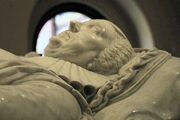
His wife, an elderly lady, still in the fashions of the sixteenth century. V and A museum, London

Detail of the wife's sleeves and probably lace cuffs. V and A museum, London
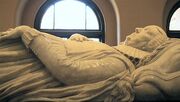
Detail of her bodice and sleeves. V and A museum, London

Thomas Paramore who died in 1620. He wears a long outer gown, a short belted doublet, breeches and a large ruff. Church at Minster-in-Thanet, Kent

The wife of Thos Paramore. She wears a tight bodice with prpbably lace cuffs and a large ruff. Her skirts show added decoration. Church of Minster-in-Thanet, Kent

A woman in widow's dress. She wears black which was expensive. A hooded cloak, a large ruff and wide skirts probably over a farthingale. Nettlestead church, Kent

Another widow in a skirt with fartingale. She wears a dark veil. Black was a hard colour to make a so very expensive. Church at Nettlestead, Kent

Lady Anne Colepeper c 1608. A cap, large ruff and long gown that falls from the shoulder at the back. Goudhurst church, Kent

The sons of Sir Alexander Colepeper. The eldest wear armour but the younger ones wear doublets, short cloaks and wide collared shirts. Goudhurst church, Kent

Sir Thomas Selwyn died 1613. He wears armour strapped over his breeches and leg armour. Friston church, Sussex.

The wife of Sir Thos Selwyn c 1613. She wears a large ruff, bodice, a wide skirt with a farthingale, and a sleeveless robe. Friston church, Sussex

Daughters of Thos Selwyn. Those carrying skulls died young. They are all dressed as adults with large ruffs, and gowns with trailing sleeves and farthingales. They have rather strange elaborate hairstyles. Friston church, Sussex

One of the daughters of Thos Selwyn showing the buttons on her bodice, the frill around her skirt held out by a farthingale, her ruff and hairstyle. Friston church, Sussex

Josias Selyard died 1609. He wears a long fur lined gown with hanging sleeves and a ruff. The sleeves of his doublet show. Biddenden church, Kent

Anne Austen wife of Josias Selyard. She wears a tight bodice, sleeves that may detatch, a skirt with a farthingale, a ruff and a soft hat with a band. Biddenden chruch, Kent

Three of the children of Josias Selyard. The males wear short high-necked doublets, breeches and short cleaks with collars. The female wears a tight bodice with a collar and ankle-length skirts probably over a farthingale. She also has a cap maybe with an affitet. Biddenden church, Kent

Bernard Randolph died 1628. He still wears the long fur lined gown with hanging sleeves of the late sixteenth century with a small ruff and probably lace cuffs on his doublet sleeves. Biddenden church, Kent

William Randolph died 1642. He wears a short cloak with a buttoned doublet and wide topped boots. Biddenden church, Kent

John Somerset died 1663. The very eleborate dress of the mid-17th century man with a wide shirt with ribbons and a javot, a sash and a plain coat. The surround indicates a military history. Brent Knoll church, Somerset

The first wife of John Somerset. She wears a wide sleeved bodice with a large lace collar and bow over a smaller tall collar. A lace cap is worn under an enourmous hat. Brent Knoll Church, Somerset.
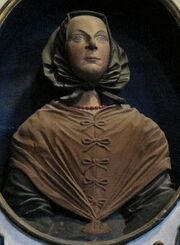
The second wife of John Somerset wears a loose hood and a cape fastened with small bows over a wide sleeved bodice. She has a string of beads. Brent Knoll church, Somerset

The wife of Ambrose Warde from a monument of 1656. As a widow she wears a veil over her hood. A short sleeved bodice that shows the probably lace cuffs of her wide sleeved chemise. Her skirt is tied at the front and has a loose overskirt. Yalding church, Kent

The sons of Ambrose Warde, c 1656. They wear short coats with buttons and cuffs, javots and breeches above long socks and healed shoes. Their hair is worn long and curled as was the fashion. The baby shows swaddling which was thought necessary to make a child's limbs grow traight and strong. Yalding church, Kent

Two daughters of Ambrose Warde c 1656. They wear short sleeved bodices that show the wide sleeves of their chemises which are caught up by ribbons. They have loose overskirts above their skirts. Their curled hair shows from beneath their caps. The bodices appears to be low necked. Yalding church, Kent
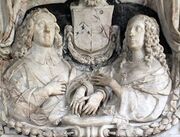
Walter Roberts and his wife c 1652. He wwears a buttoned doublet with cuffs and buttoned sleeves. His hair is long as was the fashion. His wife wears a low cut bodice with a string of pearls and a brooch. Her sleeves are wide and loose beneath a shawl. Her heair is long and curled. Brenchley church, Kent
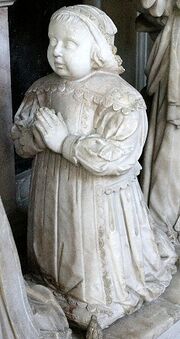
An infant girl of c 1630. She wears a wide sleeved and skirted bodice and long skirt with a large lace collar. Over this is an apron. Her ahir is covered by a lace cap. Everything seems to be edged with lace. Edington church, Wiltshire

A small boy c 1630. He wears a loose sleeved, buttoned and skirted doublet with a wide lace collar. The doublet is tied in fron t by ribbons. Beneath is a shirt with lace cuffs. He wears skirts tied in front. Boys wore skirts at this period when they were young until they moved up to wearing breeches. Breeching was the accasion for a party. Edington church, Wiltshire

A real musketeer boot with wide top and spur. It does not look all that comfortable. Shoe Museum, Romans-sur-Isere, France

Child shoes of the early 17th century (Louis XIII). Shoe Museum, Romans-sur-Isere, France

Heeled shoes for wearing at the court of Louis XIV. The uppers are fabric decorated with silver lace. Shoe Museum, Romans-sur-Isere, France

Male shoe in brocade with a ribbon. For wearing at the court of King Louis XIV. Shoe Museum, Romans-sur-Isere, France

Highly decorative clogs of the 17th century. Probably made for a special occasion. Shoe Museum, Romans-sur-Isere, France

An ordinary laced shoe of the 17th century. From the Netherlands. Shoe Museum, Romans-sur-Isere, France

A Canadian moccasin boot decorated with beads and pearls. 17th century. Shoe Museum, Romans-sur-Isere, France

Shepherds from altarpiece. They wear tunics and loaks but are bare legged. 17th century. Church of St Thegonnec, Brittany, France
All items (1)